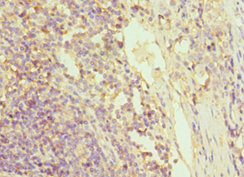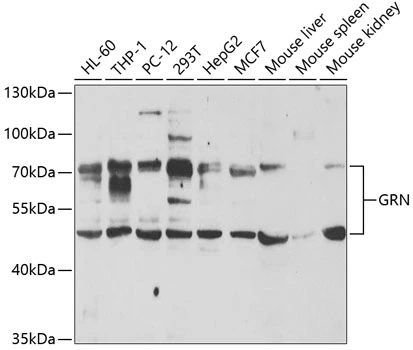Granulins antibody
GTX100803
ApplicationsImmunoFluorescence, Western Blot, ImmunoCytoChemistry, ImmunoHistoChemistry, ImmunoHistoChemistry Paraffin
Product group Antibodies
TargetGRN
Overview
- SupplierGeneTex
- Product NameGranulins antibody
- Delivery Days Customer9
- Application Supplier NoteWB: 1:500-1:3000. ICC/IF: 1:100-1:1000. IHC-P: 1:100-1:1000. *Optimal dilutions/concentrations should be determined by the researcher.Not tested in other applications.
- ApplicationsImmunoFluorescence, Western Blot, ImmunoCytoChemistry, ImmunoHistoChemistry, ImmunoHistoChemistry Paraffin
- CertificationResearch Use Only
- ClonalityPolyclonal
- Concentration1.43 mg/ml
- ConjugateUnconjugated
- Gene ID2896
- Target nameGRN
- Target descriptiongranulin precursor
- Target synonymsCLN11, FTD2, GEP, GP88, PCDGF, PEPI, PGRN, progranulin, PC cell-derived growth factor, acrogranin, epithelin, glycoprotein 88, glycoprotein of 88 Kda, granulin-epithelin, granulins, proepithelin
- HostRabbit
- IsotypeIgG
- Protein IDP28799
- Protein NameProgranulin
- Scientific DescriptionGranulins are a family of secreted, glycosylated peptides that are cleaved from a single precursor protein with 7.5 repeats of a highly conserved 12-cysteine granulin/epithelin motif. The 88 kDa precursor protein, progranulin, is also called proepithelin and PC cell-derived growth factor. Cleavage of the signal peptide produces mature granulin which can be further cleaved into a variety of active, 6 kDa peptides. These smaller cleavage products are named granulin A, granulin B, granulin C, etc. Epithelins 1 and 2 are synonymous with granulins A and B, respectively. Both the peptides and intact granulin protein regulate cell growth. However, different members of the granulin protein family may act as inhibitors, stimulators, or have dual actions on cell growth. Granulin family members are important in normal development, wound healing, and tumorigenesis. [provided by RefSeq]
- Storage Instruction-20°C or -80°C,2°C to 8°C
- UNSPSC12352203
References
- Kahle JJ, Gulbahce N, Shaw CA, et al. Comparison of an expanded ataxia interactome with patient medical records reveals a relationship between macular degeneration and ataxia. Hum Mol Genet. 2011,20(3):510-27. doi: 10.1093/hmg/ddq496Read this paper







